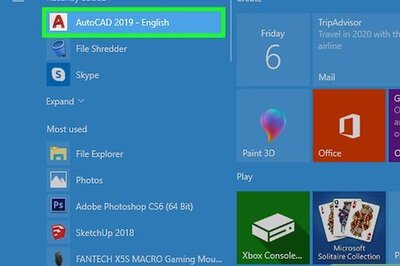
views
GUAYAQUIL, Ecuador: The signs that an attack was imminent inside the largest prison in Ecuadors coastal city of Guayaquil could not have been clearer.
There had been talk among inmates of the Litoral Penitentiary for days that a group was going to attack another. Then, early Friday morning, police arrested three men trying to smuggle two rifles, five handguns, three grenades, sticks of dynamite and hundreds of rounds of ammunition into the lockup.
Hours later police announced what the prisoners inside Litoral already knew: The three men detained belonged to a prison gang that was stockpiling weapons.
What happened hours later confirmed there were many more weapons already inside. Late Friday, a brutal attack was launched and clashes among rival gangs lasted for hours into early Saturday. When the dust settled and authorities had regained control, they found at least 68 inmates dead and 25 wounded in what was only the most recent massacre in Ecuadors troubled penitentiary system.
So far this year, at least 334 inmates have died in different clashes in the Guayaquil prison, including 119 inmates in an attack in September.
The Associated Press contacted a prisoner in one of the 12 cell blocks or pavilions that make up the prison to hear firsthand what happened before and during the deadly confrontation, and how gangs operate inside the lockup. AP confirmed the identity of the inmate, who asked not to be identified for fear of being killed. He has served five years of a 25-year sentence for murder but says he is not a member of any gang and tries to stay neutral.
In the days before the attack, inmates had already heard that an attack was coming and that the target would be Pavilion Two, the transitory pavilion where new inmates arrive and are held until space is found to accommodate them, he said.
The rumors turned out to be true.
The inmate said the shooting began at 7 p.m. Friday and he hid under his cement bunk in a cell of about eight square meters (about 85 square feet) that held 12 inmates. He asked that his cell block not be identified to prevent gang members from finding out who he is.
For years until 2020, the Litoral Penitentiary was controlled by the Choneros. But after the killing last year of its leader, Jorge Luis Zambrano, an internal dispute began over control of the gang. Authorities consider factions of the gang responsible for the massacres inside the prison.
Prison officials talk of at least six factions: the Lobos, JR, Tiguerones, the Fito, Samir and Ben10. Police have not said which group was behind Fridays attack. They say some gangs have connections with Mexicos Sinaloa and Jalisco New Generation drug cartels.
Here you sleep with one eye open, the inmate said. And now, he said, word is spreading inside the prison of attacks on other pavilions in a few days. They want to break you … and gain control of the drug-trafficking routes and micro-trafficking, or local drug sales.
At the Litoral Penitentiary, he said, everything is arranged with massacres, extortion. If you dont cooperate you die, they decide who lives, who dies, who gets rich.
The Litoral is designed for 5,000 inmates but currently holds more than 8,500. The arrested leaders of Ecuadors main drug trafficking gangs are held there. They are disputing not just international drug trafficking Ecuador is a drug transit country neighboring Colombia and Peru but local sales as well.
Pablo Arosamena, the governor of Guayas state where Guayaquil is located, recently told reporters that profits from internal drug sales in Ecuador are very high. While a kilogram brick of cocaine can be sold outside Ecuador for $35,000, when broken down and sold to users inside Ecuador the same amount can earn up to $100,000, he said.
Authorities say they are trying to control what goes on in the prison and, among other things, have installed a network of cellphone jammers to prevent inmates and gang leaders from communicating with the outside world.
But it doesnt seem to be working: AP spoke to the inmate inside Litoral using a cellphone. What they do is useless, here we have a better signal here than outside, he said.
One question often asked after a massacre is how the gangs get so many weapons inside the prison.
The inmate said that there is collusion between the prisoners and guards and that weapons enter in food trucks and are sometimes even brought in by members of the police themselves.
The mafia always works by squeezing the families of people working inside the prison, he said.
Such is the control of the prisons by gangs that members sometimes even leave the prison and return bringing weapons, like the three men arrested Friday hours before the attack.
They are emissaries of the bosses. They can leave, but they have to return because if they dont return (to the prison) they die. Here the bosses control everything, the inmate said
Gen. Marco Villegas, the polices prison control delegate, said the three inmates who tried to smuggle in the weapons would have jumped a wall to get to the street where someone would be waiting for them with the guns to bring back over the wall.
Authorities have declared successive states of emergencies in the prison system trying to end the killings and have sent hundreds of police in for searches, but without any discernable success.
According to Ecuadors constitution, in force since 2008, regular police officers cannot remain inside prisons, and soldiers cannot enter at all, even in situations of extreme violence. That leaves only the guards.
The government is responsible for omission, said lawyer Joffre Campaa, founder of Goberna & Derecho, a group that researches legal issues related to governance.
He said the prison crisis won’t be solved by states of emergencies or search raids.
It is a structural, complex problem, and they only give us temporary and populist answers, Campaa said.
___
Associated Press writer Gonzalo Solano in Quito, Ecuador, contributed to this report.
Disclaimer: This post has been auto-published from an agency feed without any modifications to the text and has not been reviewed by an editor
Read all the Latest News here

















Comments
0 comment